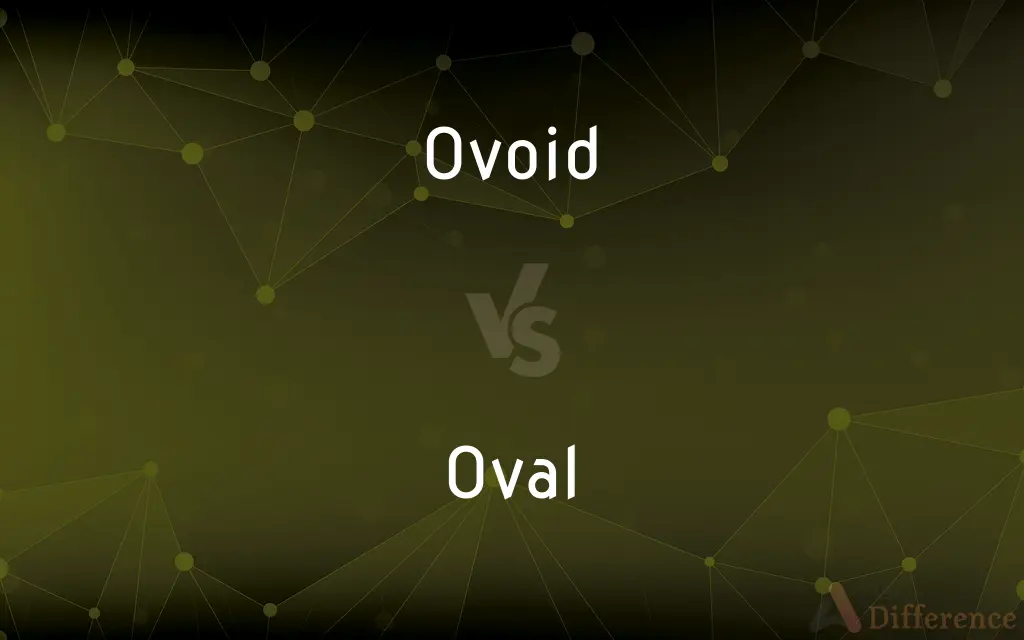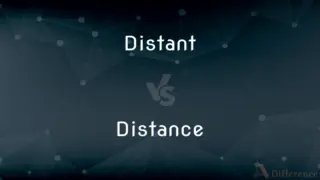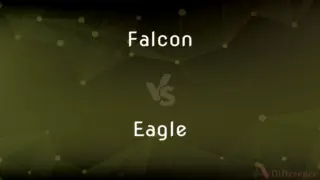Ovoid vs. Oval — What's the Difference?
Edited by Tayyaba Rehman — By Fiza Rafique — Updated on March 7, 2024
Ovoid refers to a three-dimensional, egg-shaped object, emphasizing volume, while oval describes a two-dimensional, elongated circle shape, focusing on outline or plan.

Difference Between Ovoid and Oval
Table of Contents
ADVERTISEMENT
Key Differences
Ovoid shapes are specifically related to objects that resemble the shape of an egg, implying a three-dimensional form with one end typically more rounded than the other. On the other hand, oval shapes refer to elongated circles that are flat and two-dimensional, resembling an egg but without implying the three-dimensional volume that "ovoid" does. Ovals are commonly found in design, architecture, and the visual arts, where the outline of the shape is the focus.
While both shapes are similar in that they are rounded and lack sharp edges, the key difference lies in their dimensions. Ovoid objects have depth, width, and height, making them volumetric, whereas oval shapes have only length and width, fitting into the category of flat shapes. This distinction is crucial when discussing objects, designs, or patterns in various contexts, from natural forms to man-made objects.
In practical applications, ovoid shapes are often used to describe items that need to convey a sense of volume, such as pottery, certain types of furniture, or natural objects like stones and eggs. Meanwhile, oval shapes are frequently used in graphic design, logos, and framing devices in photography and painting, where the emphasis is on creating a visually appealing outline or plan without the need for three-dimensional representation.
Despite their differences, both ovoid and oval shapes share a similarity in being visually soft and organic, often used to convey a sense of natural elegance and simplicity. Their rounded edges and lack of angularity make them pleasing to the eye, whether in two-dimensional or three-dimensional form. However, the choice between using "ovoid" or "oval" depends on whether the speaker wishes to convey a sense of volume or simply describe the shape's outline.
Comparison Chart
Dimensionality
Three-dimensional (3D)
Two-dimensional (2D)
ADVERTISEMENT
Shape
Egg-shaped, with volume
Elongated circle, flat
Usage Context
Biology, 3D objects, natural forms
Design, graphics, 2D art
Characteristics
One end more rounded, volumetric
Evenly rounded, focuses on outline
Examples
Egg, certain cells, pottery
Racetracks, picture frames, logos
Compare with Definitions
Ovoid
Resembling an egg in shape.
The artist sculpted an ovoid vase.
Oval
Elongated, circular shape, two-dimensional.
She wore an oval pendant.
Ovoid
Seen in natural and man-made objects.
The ovoid shape of some fruits.
Oval
Used in design and architecture.
The building featured an oval courtyard.
Ovoid
Used in biology to describe cell shapes.
The ovoid nucleus of some cells.
Oval
Can describe flat, visual elements.
The mirror had an ornate oval frame.
Ovoid
Three-dimensional and egg-shaped.
An ovoid pebble smoothed by the river.
Oval
Focuses on outline or perimeter.
An oval racetrack for horse racing.
Ovoid
Implies volume and roundness.
The ovoid form of traditional pottery.
Oval
Common in logos and graphic design.
The company logo is an elegant oval.
Ovoid
(of a solid or a three-dimensional surface) more or less egg-shaped.
Oval
An oval (from Latin ovum, "egg") is a closed curve in a plane which resembles the outline of an egg. The term is not very specific, but in some areas (projective geometry, technical drawing, etc.) it is given a more precise definition, which may include either one or two axes of symmetry of an ellipse.
Ovoid
An ovoid body or surface.
Oval
Having a rounded and slightly elongated outline or shape like that of an egg
Her smooth oval face
Ovoid
Shaped like an egg
An ovoid fruit.
Ovoid spots.
Oval
A body, object, or design with an oval shape or outline
Cut out two small ovals from the felt
Ovoid
Something that is shaped like an egg.
Oval
Resembling an egg in shape.
Ovoid
Shaped like an oval.
Oval
Resembling an ellipse in shape; elliptical.
Ovoid
Egg-shaped; shaped like an oval, but more tapered at one end; ovate.
Oval
An egg-shaped or elliptical form or figure.
Ovoid
Something that is oval in shape. Category:en:Curves
Oval
An elliptical track, as for racing or athletic events.
Ovoid
Resembling an egg in shape; egg-shaped; ovate; as, an ovoidal apple.
Oval
An elongated round shape resembling an egg or ellipse. Category:en:Curves
Ovoid
A solid resembling an egg in shape.
Oval
A thing having such a shape, such as an arena.
Ovoid
An egg-shaped object
Oval
(math) In a projective plane, a set of points such that no three are collinear and there is a unique tangent line at each point.
Ovoid
Rounded like an egg
Oval
(AU) A sports field, typically but not exclusively oval in shape.
Oval
Having the shape of an oval.
Oval
Of or pertaining to an ovum.
Oval conceptions
Oval
Of or pertaining to eggs; done in the egg, or inception; as, oval conceptions.
Oval
Having the figure of an egg; oblong and curvilinear, with one end broader than the other, or with both ends of about the same breadth; in popular usage, elliptical.
Oval
Broadly elliptical.
Oval
A body or figure in the shape of an egg, or popularly, of an ellipse.
Oval
A closed plane curve resulting from the intersection of a circular cone and a plane cutting completely through it;
The sums of the distances from the foci to any point on an ellipse is constant
Oval
Rounded like an egg
Common Curiosities
Why are oval shapes popular in design?
Oval shapes are visually pleasing and can create a sense of harmony and balance, making them popular in graphics, architecture, and decorative arts.
Where is the term "ovoid" commonly used?
It's often used in biology, art, and descriptions of natural objects to denote a volumetric, egg-like shape.
How do artists and designers decide between using ovoid and oval shapes?
The choice depends on the desired visual effect and whether the emphasis is on volume (ovoid) or outline (oval).
Can the terms "ovoid" and "oval" be used interchangeably?
While similar, they should not be used interchangeably due to their differences in dimensionality and implied shape.
How does dimensionality affect the use of "ovoid" vs. "oval"?
Dimensionality is key; "ovoid" implies a three-dimensional form with depth, whereas "oval" describes a flat, two-dimensional shape.
What are some common examples of oval objects?
Picture frames, racetracks, and decorative elements in graphic design often feature oval shapes.
What is the primary difference between ovoid and oval?
Ovoid describes a three-dimensional, egg-shaped form, while oval refers to a two-dimensional, elongated circle.
Can an object be both ovoid and oval?
An object can have an ovoid volume and an oval outline when viewed from a specific angle, but the terms emphasize different aspects of shape.
Are there specific industries or fields where ovoid shapes are preferred?
Yes, in pottery, sculpture, and certain biological contexts, ovoid shapes are preferred for their natural, volumetric qualities.
What role do ovoid and oval shapes play in aesthetics?
Both shapes contribute to aesthetics by providing soft, organic lines that are often perceived as more natural and appealing.
Share Your Discovery

Previous Comparison
Distant vs. Distance
Next Comparison
Falcon vs. EagleAuthor Spotlight
Written by
Fiza RafiqueFiza Rafique is a skilled content writer at AskDifference.com, where she meticulously refines and enhances written pieces. Drawing from her vast editorial expertise, Fiza ensures clarity, accuracy, and precision in every article. Passionate about language, she continually seeks to elevate the quality of content for readers worldwide.
Edited by
Tayyaba RehmanTayyaba Rehman is a distinguished writer, currently serving as a primary contributor to askdifference.com. As a researcher in semantics and etymology, Tayyaba's passion for the complexity of languages and their distinctions has found a perfect home on the platform. Tayyaba delves into the intricacies of language, distinguishing between commonly confused words and phrases, thereby providing clarity for readers worldwide.
















































